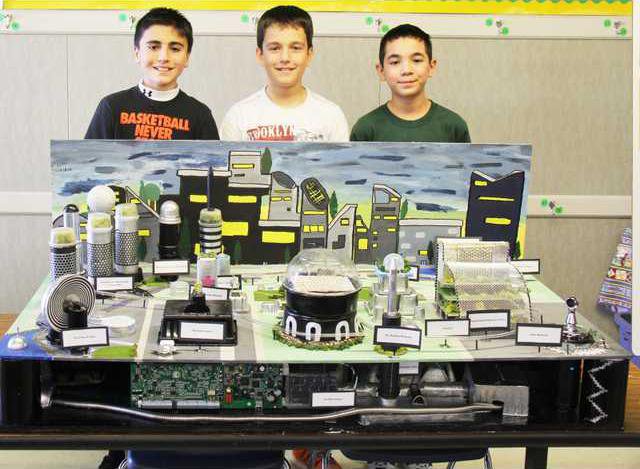Students from Walnut Elementary, Dutcher Middle School and Turlock Junior High School are taking learning to a new level by using the basic building blocks of education – math and science—to engineer a scale model of a future city.
The Future City Competition is a national project-based learning experience that requires students to simulate a city using SimCity 4 Deluxe software, research solutions to real life engineering problems, create a scale model of a future city and present it before judges. The cities must involve engineering principles and implementable design techniques in the real world. Each team has a teacher serve as an advising coach and most teams had at least one engineer that served as a mentor for the project.
On Jan. 15 the three Turlock schools competed in a mock competition sponsored by the Stanislaus County Office of Education, Mercer Foods and the Education Foundation of Stanislaus County. Walnut Elementary took second place among the 12 schools in the county, but the feedback from the judges proved invaluable to all schools involved.
“It was a very good trial and really helpful to get to have that run through to help us prepare for the state competition on Saturday. It definitely improved our presentation,” said Dion Skaria, a 6th grader at Walnut and one of the three presenters.
Each team is charged with delegating three presenters that explain their project to the judges, illuminating not only the construction of the city but the motivation behind the creative choices and the realistic ways to implement their innovations.
“Last year I did the competition as a sixth grader but I wasn’t a presenter, I was an alternate. This year I decided to do it again because it was really fun and I’d like to have a career in the field,” said Aman Kaur, a presenter for the TJHS team.
The TJHS city is s a version of metropolitan area, titled Zasabchamaklen which uses each participant’s first initial of their first name, and is set in the future where pollution emissions are minimized by a hyper loop that resolves transportation issues.
Walnut Elementary's city features a public transportation system with a humanistic approach that will not impact citizens with pacemakers because of electrical rewiring and also contains a vertical garden to preserve land space while still increasing the amount of food produced.
“We researched on the computer innovative ideas and modified and expanded upon them,” said Walnut student Marcus Hawley, the city manager that was in charge of the builders who helped design and create the city.
Dutcher Middle School entered the competition late in the game but is still managing last minute additions to their project while remaining enthusiastic.
“We jumped on board last minute but the students have enjoyed working together on the project outside of school. We’ve been spending our weekends and evenings on this and we’re doing our best,” said teacher Shaveen Prasad, Dutcher’s team coach.
All of the teams have spent time outside of their school schedule to complete their projects but have noted that the extra time has helped the students grow academically through problem solving. This is Walnut’s fourth year participating in the competition while TJHS and Dutcher are in their first year. The spirit to learn is consistent across all teams.
“The kids have thought through the challenges and all of the students that went to the county competition are better for it, whether they got a trophy or not, and they’ll do their best at the state competition,” said Donna Creighton, TJHS teacher and coach.





